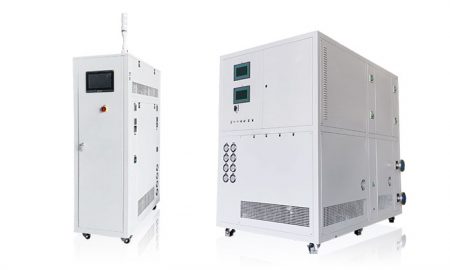Thermal Battery Energy Storage Container Liquid Cooling Chiller System Design
The thermal battery energy storage liquid-cooled chiller is a temperature control product developed for application environments such as energy storage battery heat dissipation. It is suitable for applications where the internal battery of the energy storage container generates a large amount of heat and the internal equipment is sensitive to the ambient temperature.
1. Heat dissipation plate design: The heat dissipation plate in the thermal battery energy storage liquid-cooled chiller is a key component that connects the battery with the liquid cooling system. The design of the cooling plate needs to take into account factors such as the external dimensions of the battery, the amount of heat generated by the battery, and the flow and velocity of the cooling fluid. Whether the design of the cooling plate is reasonable or not directly affects the cooling effect of the equipment.
2. Selection of coolant: The selection of coolant needs to take into account factors such as its thermal conductivity, density, viscosity and corrosiveness. In general, the cooling liquid used by thermal battery energy storage liquid-cooled chiller includes water, ethylene glycol and other coolants.
3. Flow channel design: The flow channel design refers to designing a reasonable coolant flow channel in the heat sink to ensure that the coolant can flow smoothly and effectively take away the heat generated in the heat sink.
4. The design of the liquid cooling system: including the supply, circulation, discharge and adjustment of the cooling liquid. It is also necessary to consider factors such as the connection mode between the cooling plate and the coolant, the selection of the water pump, the control of the flow rate, and the temperature adjustment. In general, thermal battery energy storage liquid-cooled chillers adopt natural circulation or forced circulation to achieve heat dissipation.
5. Design of the control system: The control system of the thermal battery energy storage liquid-cooled chiller includes sensors, controllers and actuators. The design of the control system needs to take into account the stability, performance and control accuracy of the system and other factors.

Niedertemperatur-Kühlgeräte (Benutzerdefinierte Designs)
Wir haben uns auf die Herstellung von Niedertemperaturkältemaschinen mit einem Temperaturregelbereich von bis zu -150°C spezialisiert, die den Kühlbedarf verschiedener Branchen decken.
| Temperaturbereich | Serie -25°C ~ -5°C | Serie -45°C ~ -10°C | Serie -60°C ~ -10°C | Serie -80°C ~ -30°C | Serie -110°C ~ -50°C | Serie -150°C ~ -110°C |
| Kühlleistung | 12 ~ 360kW | 6 ~ 180kW | 6 ~ 180kW | 4 ~ 180kW | 2 ~ 120kW | 2,5 ~ 11kW |

Rückkühler (Benutzerdefinierte Designs)
Unser Rückkühler arbeitet mit Niedertemperatur-Kältetechnik, die Temperatur beträgt bis zu -120℃, und verschiedene Zubehörteile sind anpassbar.
| Temperaturbereich | Serie -25°C ~ +30°C | -45°C ~ +30°C Reihe | Serie -60°C ~ -20°C | Serie -80°C ~ -20°C | Serie -120°C ~ -70°C |
| Kühlleistung | 0,8 ~ 30kW | 0,75 ~ 12kW | 0,4 ~ 6kW | 0,2 ~ 6kW | 0,3 ~ 5kW |

Raumtemperatur-Kühlgeräte / Kleinkühlgeräte (Benutzerdefinierte Designs)
Die Kältemaschine kann in verschiedenen Industrien und Labors eingesetzt werden und unterstützt kundenspezifische Designs.
| Temperaturbereich | -18°C ~ +30°C | +5°C ~ +35°C Reihe |
| Kühlleistung | 0,35 ~ 0,9kW | 1,8 ~ 50kW |
 Chillers for Automotive Battery Test (Benutzerdefinierte Designs)
Chillers for Automotive Battery Test (Benutzerdefinierte Designs)
Temperatursimulation für die Qualitätsprüfung von Fahrzeugen: Prüfung der Batterielebensdauer, Prüfstand für Einspritzdüsen/Motoren, Airbag-Prüfung, Komponentenprüfstand, usw.
| Temperaturbereich | -25°C ~ +100°C | -40°C ~ +100°C | 0°C ~ +100°C | -40°C ~ +135°C |
| Kühlleistung | 2,8 ~ 38kW | 1,2 ~ 60kW | 1.8 ~ 60kW | 4 ~ 60kW |
Temperatur/Druck/Durchfluss können unabhängig voneinander geregelt werden.
1&2: eine Maschine für zwei Kontrollgruppen.
| Temperaturbereich | -40 ~ +100℃ 1&2 | 0 ~ +100℃ 1&2 |
| Kühlleistung | 1.8kW*2 ~ 60kW*2 | 1.8kW*2 ~ 60kW*2 |
Die Temperatur bleibt konstant, Druck und Durchfluss können unabhängig voneinander geregelt werden.
1&3: eine Maschine für drei Kontrollgruppen.
1&6: eine Maschine für sechs Kontrollgruppen.
| Temperaturbereich | -40 ~ +100℃ 1&2 | -40 ~ +100℃ 1&3 | -40 ~ +100℃ 1&6 | -20 ~ +100℃ 1&6 | 0 ~ +100℃ 1&2 | 0 ~ +100℃ 1&3 | 0 ~ +100℃ 1&6 |
| Kühlleistung | 2,5 ~ 60kW | 4 ~ 60kW | 10 ~ 60kW | 10 ~ 60kW | 7 ~ 60kW | 11 ~ 60kW | 18 ~ 60kW |

Halbleiter Kühlanlagen (TES series) (Benutzerdefinierte Designs)
Geeignet für die präzise Temperaturkontrolle von elektronischen Bauteilen. Bei der Herstellung von elektronischen Halbleiterkomponenten für raue Umgebungen umfassen die Phasen der IC-Gehäusemontage sowie der Entwicklungs- und Produktionstests auch elektronische Wärmetests und andere Simulationen von Umwelttests.
| Temperaturbereich | Serie -45°C ~ +250°C | Serie -85°C ~ +200°C | Serie -60°C ~ +200°C |
| Kühlleistung | 0,3 ~ 25kW | 0,25 ~ 25kW | 3 ~ 60kW |

Halbleiter Kühlanlagen (LTS series) (Benutzerdefinierte Designs)
Geeignet für die präzise Temperaturkontrolle von elektronischen Bauteilen. Bei der Herstellung von elektronischen Halbleiterkomponenten für raue Umgebungen umfassen die Phasen der IC-Gehäusemontage sowie der Entwicklungs- und Produktionstests auch elektronische Wärmetests und andere Simulationen von Umwelttests.
| Temperaturbereich | -20°C ~ +80°C Reihe | Serie -45°C ~ +80°C | Serie -60°C ~ +80°C | Serie -80°C ~ +80°C |
| Durchflusskontrolle | 7 ~ 45 L/min | 7 ~ 45 L/min | 7 ~ 45 L/min | 7 ~ 45 L/min |

Kältemaschinen für die Energiespeicherung(Benutzerdefinierte Designs)
Liquid Cooling Solutions For Battery Energy Storage Systems
| Temperaturbereich | -45°C ~ +55°C |
| Kühlleistung | 45kW |

Schraubenkühler (Benutzerdefinierte Designs)
Niedertemperatur-Schraubenkühlmaschinen und Raumtemperatur-Schraubenkühlmaschinen
| Temperaturbereich | +5°C ~ +30°C | +5°C ~ +30°C | +5°C ~ +30°C | +5°C ~ +30°C | -25°C ~ +5°C | -25°C ~ +5°C |
| Kühlleistung | 107 ~ 1027kW (Einzelverdichter) | 299 ~ 2134kW (Doppelkompressor) | 98 ~ 934kW (Einzelverdichter) | 272 ~ 1940kW (Doppelkompressor) | 48 ~ 467kW (Einzelverdichter) | 51 ~ 497kW (Einzelverdichter) |
 LNEYA
LNEYA
 简体中文
简体中文


















































































